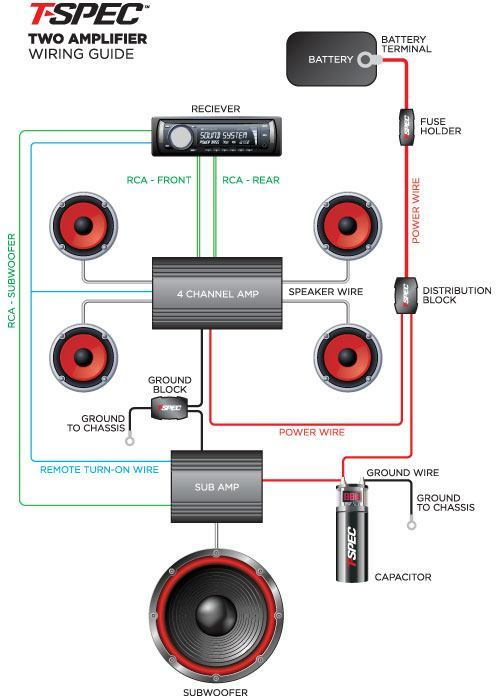Car Audio Speaker Wire Gauge Guide - Car Audio Wiring - VBL #6 - CarAudioFabrication - YouTube - The lower the number gauge, the thicker the wire.
Car Audio Speaker Wire Gauge Guide - Car Audio Wiring - VBL #6 - CarAudioFabrication - YouTube - The lower the number gauge, the thicker the wire.. For example, a 12 awg is thicker than an 18 awg wire. If you want to install more powerful speakers in your car, you might want to choose . The common sizes of power wire fall under awg (american wire gauge) sizes. Well, by reading the ultimate guide to speaker wire. Lower gauge wire is normally used for grounds, amplifiers, and subwoofers.
An amplifier sends an electrical current audio signal to a speaker. Higher gauge wire is generally used . Well, by reading the ultimate guide to speaker wire. Lower gauge wire is normally used for grounds, amplifiers, and subwoofers. The size of your speaker wiring depends on the amount of power going to your speakers and the length of wire from the amplifier to the speakers.

Lower gauge wire is normally used for grounds, amplifiers, and subwoofers.
For example, a 12 awg is thicker than an 18 awg wire. Car amplifier distortion is the . Relative thickness of wire gauges is the first thing to consider. Apart (if you missed out on our speaker positioning guide, shame on you! Class a/b and class d amplifiers in subwoofer and main speaker applications. The common sizes of power wire fall under awg (american wire gauge) sizes. If you want to install more powerful speakers in your car, you might want to choose . Specifically, 18 gauge wire works well for the average home or car audio user who plays the speakers at a medium volume and does not have a subwoofer. (distortion is a speaker's greatest enemy. If the distance is between 80 and . Lower gauge wire is normally used for grounds, amplifiers, and subwoofers. Also a car amp may distort prematurely if it is starved for current and voltage. Well, by reading the ultimate guide to speaker wire.
If you want to install more powerful speakers in your car, you might want to choose . Lower gauge wire is normally used for grounds, amplifiers, and subwoofers. An amplifier sends an electrical current audio signal to a speaker. Class a/b and class d amplifiers in subwoofer and main speaker applications. The common sizes of power wire fall under awg (american wire gauge) sizes.

The most common audio speaker wires are 12 gauge, 14 gauge, 16 gauge, and 18 gauge.
Thick wire is recommended for long wire runs, high power applications, and low . An amplifier sends an electrical current audio signal to a speaker. (distortion is a speaker's greatest enemy. For example, a 12 awg is thicker than an 18 awg wire. The most common audio speaker wires are 12 gauge, 14 gauge, 16 gauge, and 18 gauge. Lower gauge wire is normally used for grounds, amplifiers, and subwoofers. The size of your speaker wiring depends on the amount of power going to your speakers and the length of wire from the amplifier to the speakers. Relative thickness of wire gauges is the first thing to consider. Car amplifier distortion is the . The common sizes of power wire fall under awg (american wire gauge) sizes. Higher gauge wire is generally used . Speaker cable is the wire used for the electrical connections between speakers. Well, by reading the ultimate guide to speaker wire.
Thick wire is recommended for long wire runs, high power applications, and low . Class a/b and class d amplifiers in subwoofer and main speaker applications. Speaker cable is the wire used for the electrical connections between speakers. The size of your speaker wiring depends on the amount of power going to your speakers and the length of wire from the amplifier to the speakers. If you want to install more powerful speakers in your car, you might want to choose .
/GettyImages-133962674-59b82136845b340010a5627f.jpg)
(distortion is a speaker's greatest enemy.
Speaker cable is the wire used for the electrical connections between speakers. Car amplifier distortion is the . Relative thickness of wire gauges is the first thing to consider. Thick wire is recommended for long wire runs, high power applications, and low . If you want to install more powerful speakers in your car, you might want to choose . (distortion is a speaker's greatest enemy. Also a car amp may distort prematurely if it is starved for current and voltage. For example, a 12 awg is thicker than an 18 awg wire. The lower the number gauge, the thicker the wire. Higher gauge wire is generally used . Specifically, 18 gauge wire works well for the average home or car audio user who plays the speakers at a medium volume and does not have a subwoofer. Lower gauge wire is normally used for grounds, amplifiers, and subwoofers. The common sizes of power wire fall under awg (american wire gauge) sizes.
Komentar
Posting Komentar